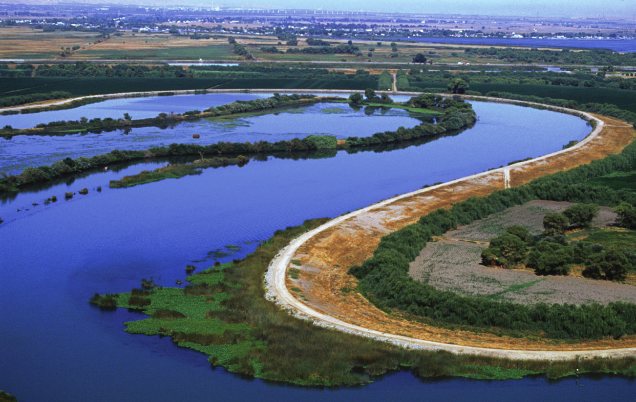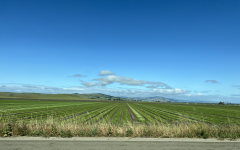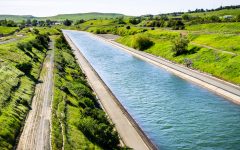
California Bay Delta water (Photo: USGS.gov)
Ringside: California’s Water Economy – The Three Biggest Choices
We could have abundance again with more reservoirs, more wastewater recycling, more urban runoff harvesting, and desalination
By Edward Ring, July 18, 2024 2:45 am
 If water strategy in California had to be distilled down to just three projects with the greatest impact, the answers might vary a great deal depending on who was asked. But in terms of quality of life impact, the ongoing implementation of State Water Resources Control Board to “Make Conservation a Way of Life” is the clear winner. In terms of financial impact, it’s the proposed “Delta Conveyance.” And in terms of potential to actually increase California’s water supply by a significant, game-changing quantity, it’s the San Joaquin County Blueprint’s “Fish Friendly Diversions” proposal.
If water strategy in California had to be distilled down to just three projects with the greatest impact, the answers might vary a great deal depending on who was asked. But in terms of quality of life impact, the ongoing implementation of State Water Resources Control Board to “Make Conservation a Way of Life” is the clear winner. In terms of financial impact, it’s the proposed “Delta Conveyance.” And in terms of potential to actually increase California’s water supply by a significant, game-changing quantity, it’s the San Joaquin County Blueprint’s “Fish Friendly Diversions” proposal.
Let’s consider these one at a time.
The state legislature’s approach to water scarcity has been invariably to mandate additional conservation. As we have seen, urban water use in California has declined even as population has increased. At this point, a prudent way to build resilience might be to develop more sources of water supplies, and consider any “excess” consumption to constitute a safe surplus that leaves room to further reduce demand if a truly perilous situation develops. A failed levee in the Delta; a cyber attack on the Tehachapi pumps; a crashed power grid. Leaving some fat in the system is common sense.
Prioritizing more supply, however, is not on the minds of California’s water bureaucrats. They are in the process of mandating a reduction in indoor water use to 40 gallons per person per day, with similar restrictions on outdoor water use. Imagine the heat island impact, the inconvenience of constantly reporting how many people per household, the trees that die because their roots were oriented to surface watering of the now dead grass, the annoyance of having to justify and report your landscaping choices, and the cost to install dual meters (indoor and outdoor) to monitor compliance, and the cost to hire enforcement officials. What a mess. What a waste.
An independent study estimated the cost to implement this next level of urban water rationing at $7 billion. By the state’s own projections, it will save 400,000 AF/year. Recall that California receives 180 million acre feet of rain in the average year. That’s $7 billion to put two-tenths of one percent of California’s total water budget back into the system. It’s absurd.
The champion project in terms of financial impact is the delta tunnel project, officially referred to as the “Delta Conveyance.” This 45 mile long tunnel will have the capacity to move up to 4 million acre feet per year from the Sacramento River safely under the fragile delta ecosystem, delivering water to southbound aqueducts. That’s not bad. But storage facilities along the Sacramento River aren’t nearly up to the task of storing enough water to allow the tunnel to operate year-round at capacity. The state’s own estimate of the tunnel’s eventual throughput at 500,000 acre feet per year.
To put this into perspective, 500,000 acre feet will irrigate around 150,000 acres. The San Joaquin Valley has 5 million acres of irrigated farmland. And this tunnel is officially estimated to cost $20 billion (recently increased from $16 billion). Does anyone honestly think it will be built at that price? The Sierra Club has come up with an estimate of $56 billion. That’s probably more like it.
If there were a realistic possibility of operating the Delta Conveyance at even half capacity, an investment of this magnitude would begin to make sense. But anyone who favors building this monstrous project must recognize the opportunity cost of other more cost-effective water supply project options.
It really comes down to this: If they don’t want to waste 20-30 years and $20-50 billion, advocates for the Delta Conveyance will need to devote equal or greater time to countering the laws, regulations, agencies, and litigants who are going to make certain that tunnel never gets built, or if it ever does get built, never operates at anywhere near its capacity.
There are alternatives, which brings us to our third example, a project proposal with a huge and unambiguously positive potential impact. Another way to transport water from the delta to farms and cities in Southern California is via so-called Fish Friendly Delta Diversions. This proposal is so promising, offering such a cost-effective way to move so much water, that it ought to be a research priority at every water agency in the state. If it lives up to its potential, it would fix everything, and harm nothing.
The proposal calls for a channel to be cut in an island in the delta, with a liner in the bottom and perforated pipes buried under rocks. The pipes would withdraw water using nothing but gravity, which would not alter the current and would not trap fish. Initial pilot studies indicate that a 200 acre channel could withdraw 15,000 acre feet per day. And the estimated cost? About $5 billion; maybe less. For such a relative pittance, you could build this, and build the tunnel.
That cost estimate includes conveyances to not only get this water into the San Joaquin Valley’s network of aqueducts, but also into new large scale storage. Another tremendous opportunity lies in the possible utilization of ancient streambeds, now underground, which could facilitate rapid transfer of water into vast underground storage.
There are other ways to increase water supplies. All of them have their virtues, and if Californians were willing to invest in abundance again, we might do them all. More reservoirs, more wastewater recycling, more urban runoff harvesting, and desalination. But in an era of tight budgets and tough environmental concerns, fish friendly delta diversions may be the answer we’ve been looking for.
We’ve already “made conservation a way of life” in California. The choice we should be making now should be to stop short of strictly rationing urban water demand at tremendous expense, and instead incentivize investment to increase supply.
- Ringside: Will Advocates for More Water Supply Projects Find Unity? - December 11, 2025
- Ringside: EVs and California’s Future Demand for Electricity - December 4, 2025
- Ringside: Politically Viable Water Supply Projects - November 27, 2025





We recently received a notice from our local water system stating that “because conservation efforts have been so successful, we need to raise your rates to cover cost increases in purchased water AND pension and administrative cost increases!!!
We did what they wanted, our lawn looks like hell, and now we’re gonna PAY MORE going forward as thanks for meeting THEIR conservation goals!!!
For GOD’S SAKE, living in this state is SO friggin STRESSFUL because of the RANK STUPIDITY continually exhibited by those in charge of water, power, insurance and energy policies! This state is CLOWN WORLD and it’s MADDENING to live here!!!